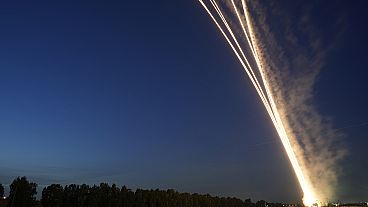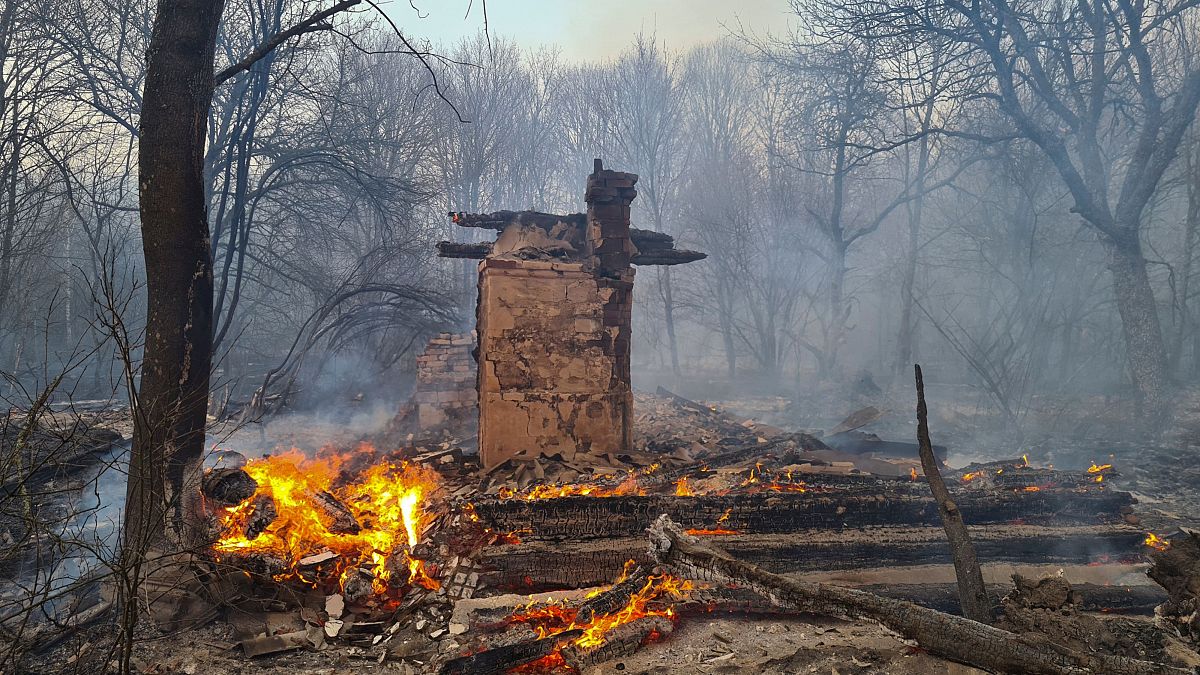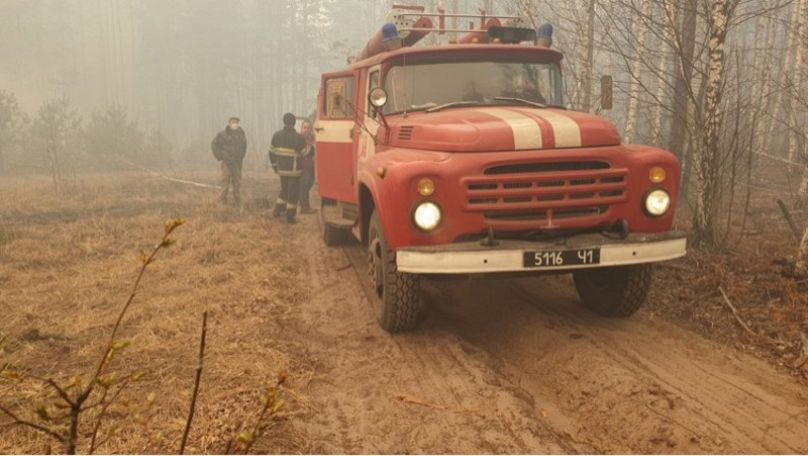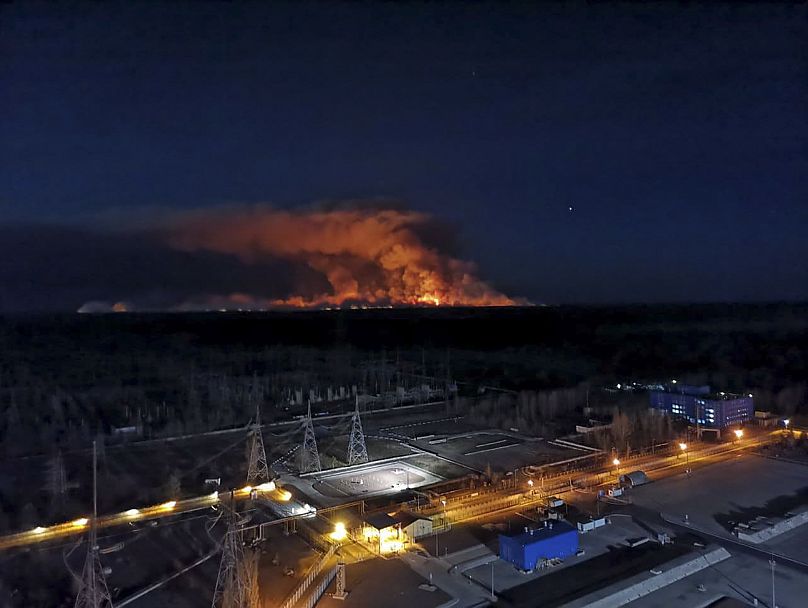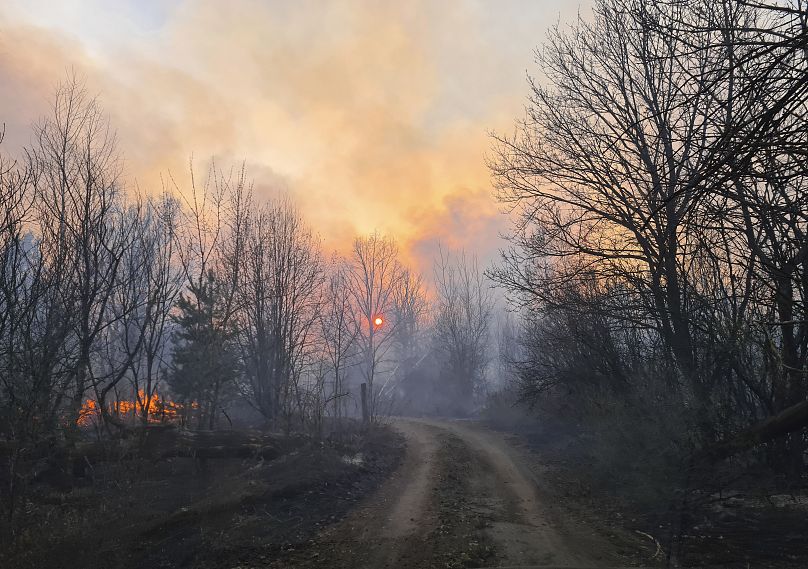Claims have been made that firefighters are ill-equipped and not properly organised to safeguard the Chernobyl Exclusion Zone, where fires recently put the area, and those operating in it, at terrible risk.
When fires broke out inside the closed 30-kilometre zone around Chernobyl this spring sending huge amounts of smoke over Kyiv, many feared there would be issues with radiation.
The Ukrainian capital temporarily had the worst air quality in the world as hundreds of firefighters, supported by helicopters and planes, fought the devastating fire. It only went out after several weeks thanks to some help from heavy rainfall.
The European Space Agency used the Copernicus Sentinel-2 satellite to map the spread of the fires, noting the threat of "increased radiation from the burning of contaminated forest and soil."
The fires destroyed multiple tourist sites and threatened nuclear waste storage facilities inside the Chernobyl Exclusion Zone - the site of the colossal 1986 nuclear accident.
Luckily radiation levels remained low. France's Institut de Radioprotection et de Sûreté Nucléaire (IRSN) noted the readings 'did not reveal abnormal values.' But those with intimate knowledge of the site fear the fires, and the way they were dealt with, demonstrate just how vulnerable the zone is to potentially catastrophic consequences.
“It was complicated for firefighters to get to certain places inside the zone because state agencies had not taken care of the woods properly,” asserts Yaroslav Yemelianenko, head of the travel company Chernobyl Tour.
“A lot of fallen trees made it possible for the fire to spread quickly in the thick and wild forests. We also saw that there was no planning. Every time someone had to be sent somewhere, the information had to go to the officers, who then would decide to send firefighters and equipment, but when they finally decided to do so, the fire would be five times bigger, and had spread to another place.”
Because of quarantine measures due to COVID-19, many journalists were not able to travel to the zone, but Yemelianenko got there and reported what he saw on Facebook. He says he saw evidence of "ill-equipped firefighters, lousy management, lack of coordination, and disinformation from the government." He believes more must be done to secure the area, starting with a better fence and more patrolling.
He questions the security of the site, asserting that it is easy for anyone to sneak past the manned checkpoints around the perimeter.
“The highly radiative objects from the Chernobyl explosion are all guarded by barbed wire with guards, and so I am not worried about those. But the zone also has other radiative objects. They are not radioactive enough to be under such protection, but they are still radioactive. It seems that anyone can reach all around the exclusion zone."
Firefighters unprepared
Maxim Pisarsky is the chairman of the trade union of fire rescue workers in the eastern city of Zaporizhia, and he is a member of a movement trying to create better working conditions for firefighters across Ukraine. He has been in contact with several firefighters who worked in Chernobyl during the fires and reports that they have outdated equipment and mostly use almost 30-year-old ZIL-131-trucks, which often break down, creating more operational instability. Yemelianenko meanwhile, says he has seen the fire trucks from the fires caused by the 1986 disaster fighting the 2020 fires. "These same vehicles were photographed this spring. Thirty-four years after the accident the fire trucks are just the same," he said. Euronews has not yet been able to verify that this particular truck dates from that long ago but a source from the fire department told our reporter that it looks like a truck dating "from around 1985 to 1987."
”If you compare our DSNS (State Service of Ukraine for Emergencies) with some European or American fire and rescue services, I don't even know what level we are at,” says Pisarsky.
“The main problem is not really in the equipment. It is, of course, a problem, but the main problem is leadership, management. Our management consists of unfit people.”
“When suddenly an emergency happens, we solve it thanks to the courage of some individual firefighters, and not because we are prepared, have the equipment, are well-trained or something like that,” says Pisarsky, who points out that there was no coordination in Chernobyl.
“Imagine - a bunch of units from different regions. Some chiefs say 'go and extinguish the fire'. Firefighters are doing this, and then other chiefs tell them to set fire to the same forest, which others are told to extinguish, to fight the fire.” Pisarsky is referring to two of the main ways of fighting fires: containing it by burning an area around the fire or extinguishing it by pouring water on it - both good methods when coordinated, he adds.
He also alleges that the firefighters were giving only a little water and food while spending too much time exposed to radiation.
Serhiy Vasyliovych, who is the head of State Agency of Ukraine for Exclusion Management, SAUEZM, and responsible for the safety of the zone, told Euronews that mistakes were made related to the fire and that things will need to be done differently in the future.
“For the last four years, we have not had the best situation with bad conditions inside the zone,” says Vasyliovych, who was appointed as head of the agency after the fires.
“We need more money to take care of the zone properly, but we have made a plan for the next ten years within our means, which will improve the safety of the zone.”
Vasyliovych did not want to comment on the safety issues raised by Chernobyl Tours or the standards of the Ukrainian firefighters. He says that maintaining the fence around the zone and patrolling it is the responsibility of the National Police, while DSNS is responsible for the firefighters. He says he is sure that they do a good job and that “the ten-year plan speaks for itself.”
Among other things, the plan aims to build new roads inside the zone, to maintain the forest more effectively, and install infrared sensors to detect fires earlier.
Euronews has reached out to both the Ukrainian National Police and DSNS for a comment on the criticism, but has been unable to set up an interview.
“We were not prepared”
Euronews also met with Kateryna Pavlova, who was temporarily head of SAUEZM during the fires and now works as head of international cooperation at the agency. She says that the zone has been neglected for years with woods being left unkempt, creating fertile soil for fires, and the lack of roads making it very difficult for firefighters to do their job.
“My main point is that we are and were not ready for fires because we have not seriously recognised the effects of global warming,” says Pavlova, agreeing with much of the criticism from Chernobyl Tours.
“We need international cooperation and information sharing. We need practical experience and knowledge, but this is just one thing. We need new roads inside the zone, better cleaning, more and newer fire trucks, better equipment, and a clear strategy of what to do, a sort of roadmap, of how to fight such fires.”
She says that strong winds and a dry winter and spring made it almost impossible to stop the fires, which started in the western part of the closed Chernobyl zone. It quickly spread, partly because of strong winds often outpacing firefighters, but also because of new fires starting in other parts of the area. Pavlova believes that unidentified people started some of the fires inside the zone, and she agrees that the area is vulnerable, and changes need to happen.
In Ukraine, it is not uncommon that people sneak undetected past security and inside the zone. They are often called ‘stalkers,’ and Euronews have previously been in contact with two of them, who say that security is easy to bypass.
“The zone is around 400 kilometres. It is the responsibility of the National Police to control it, but the question is, how do we control such a big area? Here at the agency, we can send letters to the National Police, which I did, and hope that things change,” says Pavlova, who also asserts that Ukrainian bureaucracy slows down decision-making even in times of emergency.
'Chaos'
While Pavlova was trying to coordinate the efforts from a distance, firefighters fought for weeks against the fires that, according to Chernobyl Tour, destroyed 30 percent of all tourist attractions and large parts of the forests. Euronews spoke to one fireman who worked during this time. He spoke on condition of anonymity due to fears of losing his job.
He alleges that everything was "chaos" inside the zone when firefighters tried to control the fires, that firefighters' lives were in danger, and that equipment measuring radioactivity was failing.
“There was no coordination between the different divisions,” he said. ”My team and I were fighting some fire when a fire truck came past yelling ‘guys, get out of here because there is fire coming this way.’ We were not given any instructions from our commander about this. The phones did not work there, the mobile phones did not work - the network was not good. The walkie-talkies were in the truck but they did not reach the headquarters. There was no information. There were no physical maps or GPS navigators. We were just blind.”
He says that in his opinion, firefighters were lucky that rain came and that he fears what would have happened if it hadn’t. He says that his team was fighting a fire at one point, when suddenly another fire broke out behind them. They found out later that another unit was told to fight the fire with fire while they were told to use water and were almost caught in the middle, but that “nobody told me anything.”
He says he was surprised when he heard authorities tell journalists that the fires were under control when they were still going strong. While authorities said that firefighters got plenty of water and food, his team of nine got six litres of water to share between them for three days, and they had to rely on other units and volunteers. He says that he only received food twice during what was around three days in the zone.
“Of course, the lack of coordination posed a risk to us. Even on Facebook, a video on the Boycott of Firefighters of Ukraine page shows how firefighters tried to escape through a burning forest in a fire truck. Of course, the temperature there is too high, and it is simply impossible to be there without protective suits and equipment. You could lose your vehicle and your life there,” he says.
